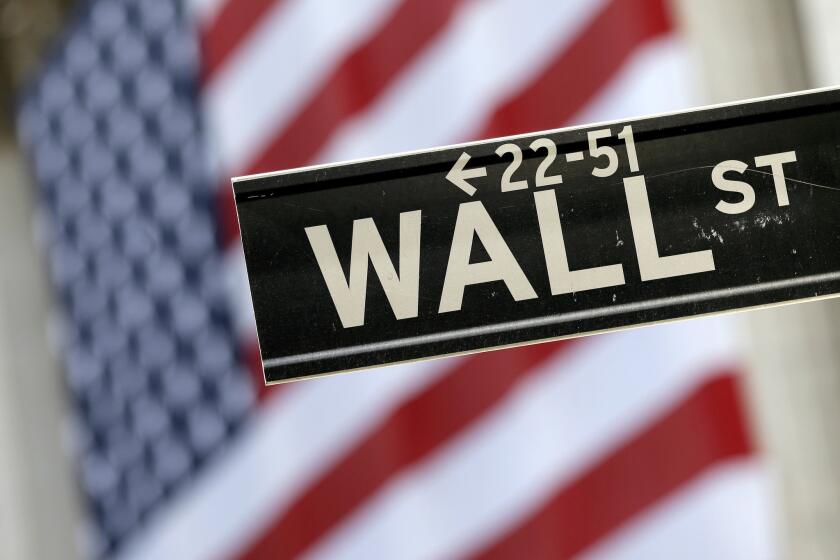U.S. economy grew 2.1% at end of 2019 as virus threatens 2020 outlook

- Share via
WASHINGTON — The U.S. economy grew at an annual rate of 2.1% in the final quarter of 2019, but damage from the spreading coronavirus is likely depressing growth in the current quarter and for 2020 as a whole.
The Commerce Department said Thursday that the overall pace of growth in the October-December quarter was unchanged from its initial estimate a month ago, though the components were slightly altered. A slowdown in business restocking was less severe than first believed. But a cutback in business investment in new equipment was more of a drag on growth than initially estimated.
Economists have been downgrading their forecasts for the first quarter of this year as fears of the virus’ impact have escalated. Stock markets have plunged this week on news that the number of coronavirus cases worldwide has now topped 81,000. The virus, which started in Wuhan, China, has spread to more than 30 countries, including the United States, Italy and South Korea.
Economists are closely watching how the spread of the coronavirus affects corporate earnings, consumer spending and interest rates.
Vital supply chains from China that companies in the United States and elsewhere depend on have been disrupted, and that problem is expected to worsen.
Those fears have inflicted the worst losses on U.S. stocks in two years, less than a week after Wall Street was hitting record highs. To try to demonstrate the government’s resolve to deal with the spread of the virus, President Trump announced Wednesday that he was appointing Vice President Mike Pence to take the lead in coordinating U.S. actions.
But economists are warning that if the virus turns into a global pandemic, the effect could be severe enough to push the global and U.S. economies into recession.
“The global economy was already very weak because of the trade war, and it would not take much to shove it on its heels,” said Mark Zandi, chief economist at Moody’s Analytics.
This week’s sharp sell-off on Wall Street eased Wednesday, with the S&P 500 and Dow notching smaller declines and the Nasdaq gaining back a little ground.
Zandi said his baseline forecast, which optimistically assumes that the outbreak remains largely contained in China and dissipates by spring, projects that global growth will slow to 2.4% this year — 0.4 of a percentage point lower because of the virus.
He expects the annual pace of U.S. growth to slow to 1.3% in the current quarter, down by 0.6 of a percentage point because of the virus. He said for the year, he is forecasting U.S. growth of 1.7%. That would be the slowest annual growth of the Trump presidency and far below the 3%-plus growth that Trump had promised to deliver during the 2016 campaign.
Because of the market turbulence and the rising potential of adverse effects from the virus, expectation of interest rate cuts by the Federal Reserve has risen. The CME Group tracker of investment sentiment has put the possibility of a quarter-point cut as early as March at 37%, up from just 7% a week ago.
Diane Swonk, chief economist at Grant Thornton, said the possibility of two rate cuts this year “has gone up dramatically” because of the virus threats.
The Centers for Disease Control and Prevention has advised communities to take precautions in the event that the coronavirus spreads.
Until recently, many economists had expected that the Fed could keep rates unchanged the whole year after three rate cuts last year, when it was struggling to cushion the impact of Trump’s trade war with China and a slowing global economy.
The estimated 2.1% annual growth pace in the October-December quarter followed an identical gain in the third quarter. For 2019 as a whole, the economy grew by 2.3%, the slowest pace since a 1.6% increase in 2016.
Trump is counting on a strong economy to propel him to reelection in November. But for each year of his presidency, economic expansion has fallen below the levels he had promised to deliver during the campaign, when he derided the growth rates achieved under President Obama.
While growth did jump to 2.9% in 2018, propelled by the 2017 tax cut and increased government spending, it returned last year to near the average achieved by Obama.
Businesses and governments haven’t been prepared for the coronavirus, so neither are we.
Thursday’s report from the Commerce Department was its second of three estimates of economic growth for the October-December quarter. It showed that consumer spending, which accounts for 70% of economic growth, grew at a 1.7% annual rate in the fourth quarter, down from an initial estimate of 1.8% growth.
Business investment on new plants and equipment was also lower, falling at a 2.3% rate, worse than the initial estimate of a 1.5% drop. These weaker numbers were offset by more business restocking of store shelves and upward revisions to residential investment and federal government spending.
More to Read
Inside the business of entertainment
The Wide Shot brings you news, analysis and insights on everything from streaming wars to production — and what it all means for the future.
You may occasionally receive promotional content from the Los Angeles Times.














